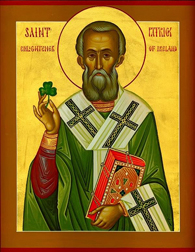On March 17, 1737, Boston became the first American city to celebrate the feast day of St. Patrick, Ireland’s patron saint.
St. Patrick’s Day Comes to America
The well-heeled members of Boston’s Irish community celebrated America’s first St. Patrick’s Day in 1737 as a gesture of solidarity among the city’s new Irish immigrants. New York would hold its first St. Patrick’s celebration in 1756 at the Crown and Thistle Tavern.
The U.S. Department of State surmises that the original celebration was probably much statelier than the revelry that characterizes the holiday today in the United States, writing that “those early American celebrants were gentlemen of means.”
That changed after the 13 original colonies gained independence. Following the revolution, America became a beacon for Irish immigrants of all socioeconomic backgrounds, and “St. Patrick’s Day festivities began to take on a decidedly less upper-class tone,” according to the State Department.
Irish History
However, traditional veneration of St. Patrick’s Day was regarded as a solely religious occasion, with commemorative Mass in the morning and a family dinner in the afternoon, History.com writes. The day commemorates Ireland’s patron saint, Patrick, who converted much of the Emerald Isle’s pagan population to Christianity in the fifth century. March 17 is the considered to be the date of his death.
Ireland only recently adopted St. Patrick’s Day celebrations as they are known in America. Until the late 1970s, Irish bars and pubs were closed on what was once considered a solemn feast day.
Sources in this Story
- U.S. Department of State: America Goes Green for St. Patrick’s Day
- History.com: St. Patrick’s Day
- The Boston Globe: ‘Where’s the Corned Beef?’
- The BBC: Saint Patrick
- New Advent Catholic Encyclopedia: St. Patrick
- University College Cork: CELT: The Corpus of Electronic Texts: The Annals of Ulster
Biography: St. Patrick
Patrick, who may have been named Maewyn Succat before his life as a bishop, was born in the late fourth century, possibly in 387 A.D., in Britain. In the Confessio, one of two surviving works written by Patrick, he says he was raised in the settlement of Bannavem Taburniae; the location of the town is unknown, though it may be Kilpatrick, Scotland, or Banwen, Wales.
His father was a deacon, but Patrick wrote that he was not a strong believer in God. When he was 16, he was captured by Irish raiders and taken to Ireland, where he worked as a shepherd and drew close to God. “I used to pasture the flock each day and I used to pray many times a day,” he wrote in the Confessio. “More and more did the love of God, and my fear of him and faith increase.”
After six years in Ireland, he escaped on a ship back to Britain after hearing a voice in his sleep telling him to return home. He was reunited with his family, but a dream urged him to return to Ireland.
He wrote in the Confessio: “I seemed at that moment to hear the voice of those who were beside the forest of Foclut which is near the western sea, and they were crying as if with one voice: ‘We beg you, holy youth, that you shall come and shall walk again among us.’”
Patrick spent the ensuing years training to be a priest. Some historians, including professor John Bury, author of the 1905 book “Life of St. Patrick,” believe that Patrick was trained in Gaul, studying first on the island of Lerins and then in Auxerre under Saint Germanus. Patrick did not write of visiting Gaul, though he did mention that he had brethren there.
Patrick is believed to have returned to Ireland around 432 A.D. to begin preaching Christianity to the predominantly pagan population. Though he was threatened and occasionally arrested by local kings, he wrote that he “baptized so many thousands of people.”
Though it is unlikely that St. Patrick was the first to bring Christianity to Ireland (Palladius, who is sometimes confused with Patrick, had been sent to Ireland by the pope to teach Christianity around 431), he played a significant role in converting the majority of Ireland’s population.
Patrick is known for using a three-leaf clover, the shamrock, to teach new believers about the Holy Trinity. He is also famous for driving the snakes out of Ireland, an apocryphal tale.
“It’s unlikely there ever were any snakes in Ireland,” explains the BBC. “The snake may be a reference to serpent, a symbol of evil, and the driving out a reference to Patrick’s mission to rid Ireland of pagan influence.”
St. Patrick is said to have died in Saul, County Down. The date of his death was recorded in the Annals of Ulster—in a section written in the seventh century—as March 17, 493, “in the 120th year of his age, in the 60th year after he had come to Ireland to baptize the Irish.” Most modern historians, however, believe he died in 460 or 461.
St. Patrick’s Writings
Reference: St. Patrick’s Day Guide
FindingDulcinea’s Guide to St. Patrick’s Day includes ideas for family-friendly celebrations and the origins of traditions associated with the holiday.











